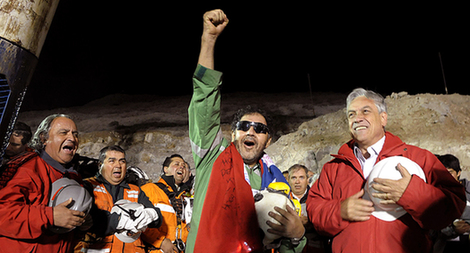Global General
Chile's rescued miners recover, offers pour in
(Agencies)
Updated: 2010-10-15 06:50
 |
Large Medium Small |
 Last miner to be rescued, Luis Urzua, celebrates with Chile's President Sebastian Pinera in Copiapo October 13, 2010.. [Photo/Agencies] |
COPIAPO, Chile – Chile's 33 rescued miners recovered from their two-month ordeal on Thursday as the offers and gifts that go along with their new celebrity status started to roll in, including an invitation to Graceland.
A day after their stunning rescue from deep inside a collapsed mine, the men underwent tests and received treatment in hospital, still wearing dark glasses to protect their eyes until they adapt to sunshine and bright lights.
| ||||
Most of the miners were in surprisingly good health considering that they were stuck in a wet, hot and dark tunnel for 69 days.
The men, who set a world record for survival underground, were finally hoisted to the surface in a rescue operation that was watched by hundreds of millions of people worldwide and triggered celebrations across Chile.
One of the miners had pneumonia and was being treated with antibiotics, and others need dental treatment, but none were suffering from serious health problems and two or three might even be allowed to go home later on Thursday.
Experts said the most lasting damage could be emotional.
Between medical tests, the miners spent time with their families on Thursday and began looking at a flood of offers ranging from financial to musical.
Edison Pena, a fan of Elvis Presley, was invited to visit the Graceland mansion that was his home in Memphis, Tennessee and now serves as a museum to the rock and roll legend.
"We heard on the news that he's a huge Elvis fan," Graceland spokeswoman Alicia Dean told Reuters.
Pena's wife said the couple was very happy with the invitation but had not yet decided when the trip would be.
Real Madrid and Manchester United invited the miners, many of whom are avid soccer fans, to watch them play in Europe.
A flamboyant local singer-turned-businessman has given them $10,000 each, while Apple boss Steve Jobs has sent them all a latest iPod and a Greek firm has offered an islands tour.
The miners were also expected to receive job offers, advertising deals and possibly contracts to sell their stories for book and film projects.
In a complicated but flawless operation under Chile's far northern Atacama desert, the miners were hauled out one-by-one through 2,050 feet of rock in a metal capsule little wider than a man's shoulders.
It took 24 hours to pull out the 33 miners and six rescuers who had gone down the escape shaft to help the men get out.
"The trip up was calm. Everything was well prepared. I came up listening to music," said miner Richard Villarroel, whose wife is expected to have a baby boy in November.
He said the worst moment was when the gold and copper mine crumbled around them on August 5. "I thought I'd never see my wife again and that I wouldn't see the birth of my son."
A Soccer Challenge
President Sebastian Pinera, whose popularity has risen over his handling of the crisis, was at the San Jose mine to greet each of the men as they were rescued and he invited them on Thursday to visit the presidential palace later this month.
Pinera, a soccer fan who also plays the game, challenged the miners to a match against his cabinet.
"The team that wins will stay in La Moneda (presidential palace). The team that loses goes back to the mine," he joked.
After suffering a massive earthquake in February that killed more than 500 people, Chileans were euphoric about the happy ending to their latest challenge and proud of the technology that went into the successful rescue. Church bells and car horns sounded across country.
When the mine caved in, all 33 men were believed to have died in yet another of Latin America's litany of mining accidents. But rescuers found them 17 days later with a bore hole the width of a grapefruit.
That tiny hole became an umbilical cord used to pass hydration gels, water and food to keep them alive until a bigger shaft could be bored to bring them up.
Mining is a crucial part of the Chilean economy and has played a central but often tragic role in Latin America since the Spanish conquistadors' first hunt for gold.
For centuries, mine conditions were appalling but they have improved radically in recent decades and the industry has helped fuel an economic boom in some nations, including Chile.
The rescue -- via a metal capsule named Phoenix after the mythical bird that rose from the ashes -- will do no harm to the reputation of Chile, which is already a model of economic stability and an investors' favorite in Latin America.



